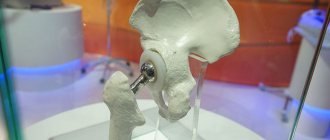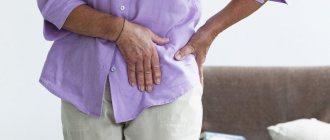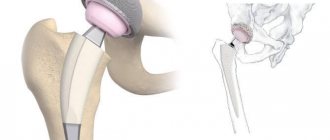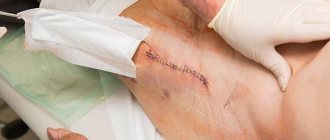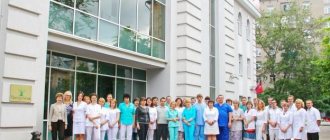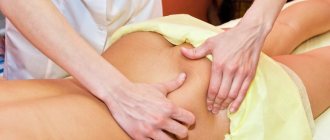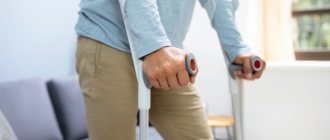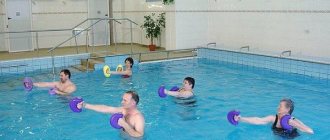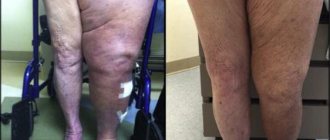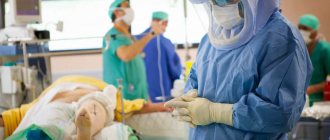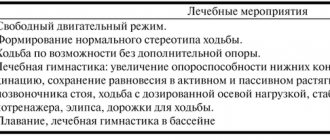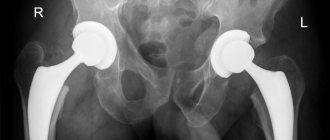With severe arthrosis of the hip joint, conservative treatment does not give the desired result. The only way to relieve a patient of pain and return him to normal physical activity is hip replacement surgery.
As with any other surgical procedure, complications can develop after hip replacement. Their occurrence is influenced by the patient’s age, the nature of the pathology in the joint, concomitant diseases, and excess weight. Therefore, before the operation begins, all possible reasons are taken into account to minimize the risk of complications in the postoperative period.
Postoperative pain
In the first month after hip replacement, the patient may experience pain and discomfort. They can be concentrated in the area of the surgical wound, spreading to the knee and groin. Such pain is considered a natural response of the body to surgical trauma (skin incision, muscle dissection). To relieve them, the patient is prescribed painkillers.
Patients may often experience lower back pain after hip replacement surgery. Typically, such pain occurs during physical activity. This is associated with an exacerbation of osteochondrosis due to the restoration of the length of a previously shortened limb and an increase in the load on the spine. With proper rehabilitation measures, back pain after hip replacement goes away over time.
Prevention of pain during hip replacement
Careful planning of the operation will help to avoid pain in the postoperative period. It will allow you to achieve the correct length of the lower limb, as well as avoid incorrect orientation of the components of the endoprosthesis. To prevent the onset of pain, surgery should be done in good clinics where experienced surgeons work. This way, the risk of postoperative complications will be minimized.
Let's summarize:
- Pain in the groin area in the late postoperative period is usually caused by lengthening of the lower limb or incorrect orientation of the prosthesis.
- The remaining pain syndrome is in no way related to the operation. Its cause may be inguinal and femoral hernias, abdominal aortic aneurysm, diseases of the genitourinary system, etc.
- High-intensity pain usually indicates the development of postoperative complications: infectious, orthopedic, etc. In this case, the patient is also worried about other symptoms: increased body temperature, impaired mobility of the lower limb, swelling of soft tissues, and the appearance of purulent discharge.
- To avoid pain and postoperative complications, the operation must be planned especially carefully - it must be done in a timely manner, by experienced doctors and undergo rehabilitation.
Postoperative complications
Despite all the measures taken to prevent complications, there is still a risk of their occurrence. They can develop due to incomplete preoperative examination of the patient or errors by the operating doctor. However, more often, improper postoperative care and non-compliance with the physical activity regimen outside the hospital are to blame for the occurrence of complications.
One of the most common complications is dislocation of the implant head. It is characterized by pain that intensifies with movement, muscle spasm around the hip joint, and forced positioning of the operated leg. Characteristic symptoms of this complication after hip replacement are lameness and shortening of the affected limb.
In the presence of an untreated chronic inflammatory process in the patient’s body, there is a possibility of developing paraprosthetic infection in the tissues surrounding the endoprosthesis. In the future, it can lead to the formation of a purulent fistula and the development of osteomyelitis. The inflammatory process is characterized by severe pain, swelling and redness in the area of the operated joint. The skin becomes hot to the touch, and the patient develops a fever.
Severe complications include periprosthetic fracture of the femur. It is characterized by acute, sharp pain, rapidly increasing swelling, redness, crunching when moving and palpating the operated area, deformation of the leg and the impossibility of active movements.
During the operation, there is a risk of damage to the fibular nerve, resulting in the development of neuropathy. It is characterized by intermittent pain of various localizations, weakness of the ankle joint, and a feeling of numbness in the toes and feet.
The most dangerous complication is pulmonary embolism, when a blood clot that breaks off during surgery clogs its lumen. The patient suddenly develops shortness of breath, weakness, and suffocation. The patient loses consciousness. If urgent resuscitation measures are not provided, death occurs. This complication is quite rare.
Prospects for treatment
Pain due to improper installation of the endoprosthesis occurs after surgery and is chronic. They are characterized by low or medium intensity, and also appear under certain conditions (after walking, when bending the lower limb, turning it outward, etc.). These features make it possible to distinguish them from other pains: those that persist and those caused by postoperative complications.
The development of complications is signaled by high-intensity pain, accompanied by other alarming symptoms. They may indicate paraprosthetic infection, displacement of the endoprosthesis, periprosthetic fractures, neuropathy of the peroneal nerve, etc. The listed complications require quick diagnosis and immediate medical care. Therefore, if you suspect their development, you should immediately consult a doctor.
Rehabilitation methods used in the recovery process
- Drug therapy - antibiotics to prevent infection in the early period, painkillers, anti-inflammatory drugs. After this - vitamin complexes, calcium supplements, immunostimulating drugs.
- Physiotherapy – techniques for improving blood circulation, stimulating metabolic processes, reducing pain and increasing muscle tone.
- Hydrokinesitherapy – water exercises to develop the joint, speed up recovery and reduce the risk of complications.
- Cryotherapy is cold therapy. Special forms filled with hydrogel are cooled and applied to the location of the endoprosthesis for 15 minutes. This relieves pain and relieves swelling.
- Magnetotherapy is a hardware technique for stimulating microcirculation in tissues and accelerating healing.
- Electrical stimulation - tissues are exposed to alternating weak current, due to which the muscles maintain tone even with limited physical activity. Lymph and blood flow improves.
- Laser therapy for anti-inflammatory effect, pain relief and swelling.
- The use of orthoses if the joint needs to be further stabilized. The orthosis (bandage) is selected by an orthopedic traumatologist. This device fixes the joint, relieves it and corrects the function of the leg. The load is redistributed to healthy areas, treatment time is reduced.
- Kinesitherapy is a set of exercises that is selected taking into account the patient’s medical history, condition and a number of other factors. The load gradually increases, using walkers, crutches, and exercise equipment. This technique allows you to restore motor function.
- Exercise therapy, which is best done under the supervision of a trainer. But in the long term, the practiced exercises can be done at home.
- Massage is indicated in the absence of acute pain. It is carried out in order to increase blood flow and saturate tissues with oxygen for better regeneration.
Video of exercises for developing the joint after surgery.
Rehabilitation in the Sports Clinic at TechnoGym multi-stations
In our programs, we use proprietary methods, special simulators, massage and an integrated approach to recovery under the supervision of several specialists - a rehabilitation specialist, an orthopedic traumatologist, and a massage therapist. Thanks to the close cooperation of the department of rehabilitation and orthopedics, the SportClinic achieves the greatest efficiency in the restoration of joints after endoprosthetics and its adaptation to the patient’s usual lifestyle. After a course of classes in our clinic, you will be able to recover as fully as possible and return to an active life in a short time!
Clinical example No. 2
Patient K., 68 years old, over the course of 1 year noted a gradual increase in pain and limited range of motion in the right hip joint. I contacted K+31 in August 2021, and an x-ray revealed aseptic necrosis of the head of the right femur and stage 3 coxarthrosis.
Total endoprosthetics of the right hip joint was performed using a cementless fixation endoprosthesis from Zimmer, a ceramic/polyethylene friction pair. Smooth course of the postoperative period.
X-rays after surgery, the position of the endoprosthesis components is correct. The patient is activated the next day after surgery, trained to walk with additional support on a walker. On the second day after surgery, the patient walks around the ward and corridor without assistance with additional support from a walker.
The patient was discharged on the 4th day after surgery in satisfactory condition. Currently, the function of support and walking has been completely restored, he walks without additional support, there is no pain, and the normal gait pattern has been restored.
Useful complex
photographer Vladimir Grigoriev tel., home phone
After recovery from anesthesia, it is recommended to perform light exercises:
- You need to wiggle your toes.
- Move your foot forward and backward.
- Rotate your foot clockwise and then counterclockwise.
These movements help improve blood flow, reduce swelling and prevent blood clots. They need to be performed every 10 minutes.
On the second day, squats on the bed are recommended. But this must be done with the help of medical staff. Already on the third day you need to get up and walk several steps, but with support. On the fifth day you need to walk 100 meters.
In addition to physical activity, breathing exercises are performed. Rehabilitation should be continued at home. In this case, the complex is done several times a day for half an hour. While lying down, perform the following movements.
In this case, repeat each 7-15 times:
- Bend your legs and move your knees to the sides at a distance of up to 20 cm.
- Bend one leg and straighten the other. At the same time, lift your pelvis up a few centimeters. It is necessary to tense the muscles of the buttocks.
- Turn onto your stomach and place a pillow under your navel. Raise your leg and reach your heel towards your buttock until you feel tension. Hold the position for 15-30 seconds. Do the same with the other leg.
- In the same position, spread your legs and bend them, and bring your heels together. You need to stay in this position for 7 seconds. This exercise cannot be done if the incision is located on the front of the thigh.
- Place a small bolster under your ankle and lift your hip until your knee straightens. Stay in this position for 7-8 seconds.
At this time, rehabilitation measures are aimed at restoring movement functions and improving muscle tone.
This complex is performed when the patient can stand up and move around with support on crutches. The following exercises can be used:
- Bring your legs together and perform slow squats. In this case, you need to bend your hip joints and knees. You need to do five repetitions. First you need to perform movements with hand support.
- Lean on the back of the bed and do leg raises with a bend at the knee.
- Lean on the headboard and smoothly lift your leg into a straight position. In this case, while lifting, the limb must be fixed for several minutes.
During this period, it is worth practicing massage treatments.
After discharge, recovery is carried out independently. In this case, rehabilitation is aimed at rapid restoration of bone tissue, as well as improvement of muscles, ligaments and tendons. Here are the exercises that are performed in a lying position:
- Lie on your back and bend your legs one at a time. Then pull them towards your stomach. In this case, you need to simulate riding a bicycle. 10-20 repetitions are done.
- Turn onto your stomach and lift your leg straight. Take her aside. Repeat with the other leg. If it is too difficult to keep your leg straight, you can bend it slightly.
- Lie on your side and place a bolster between your legs. Raise your leg and hold in this position for several seconds. Then do the same manipulations on the other side. In this case, the limb can be bent at the knee or straight.
In the later stages of the recovery period, motor function should be adapted.
In this case, you can do exercises on simulators:
- On an exercise bike, all movements must first be carried out backwards, and when it becomes easy to do, then forwards.
- Walking on a treadmill is performed at a slow pace.
- A budget option is a step machine.
Three months after surgery, the exercises can be performed while sitting or standing. Before using a complex complex, you should consult a specialist.
Here are some effective exercises:
- Stand with your shoulder to the wall on the side of your sore leg. Hold the back of the chair with your other hand. Raise the bent and operated limb along the surface of the wall. In this case, the bend angle should not be more than 90 degrees. Repeat the same, but with the other leg.
- Stand with your back to the wall surface and lean on the back of a chair. As you do this, elevate your operated hip. Then the exercise can be performed without support.
- In the same position, leaning on the chair, raise your leg to the side by 18-20 cm. In this case, the heel should slide along the wall. Hold the limb at the top point for 6 seconds.
- While sitting on a chair with your legs extended, move your leg to the side and then do the same with the other limb.
In addition to gymnastics, it is recommended to walk every day. In this case, you can choose short distances.
You also need to go up and down stairs. When lifting, you need to put on the healthy leg first, and then the sore leg.
When descending, crutches are placed forward, then the sore limb and the healthy one.
It is important that during the rehabilitation period all classes are supervised by a doctor. It will help you choose the right load.
You can't do gymnastics through pain. Fear may be the reason why recovery is too slow. Older people may experience severe anxiety. The stages of recovery may vary from patient to patient. After all, rehabilitation may require different periods of time. It is important to adhere to the recommended time limits for putting pressure on the leg.
The set of rehabilitation measures is individual and selected by a doctor. The standard program takes from 10 weeks to 7-8 months.
To speed up recovery, you need to move regularly and follow useful medical recommendations.
By setting a goal and slowly moving towards it, you will definitely achieve success and begin a fulfilling life.
bending the legs at the hip and knee joints;
